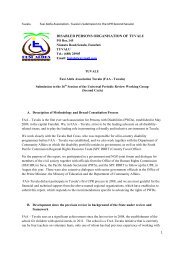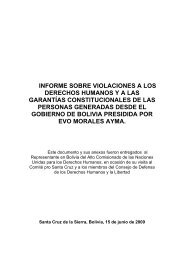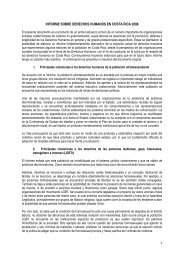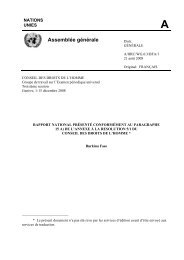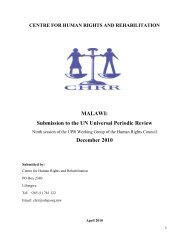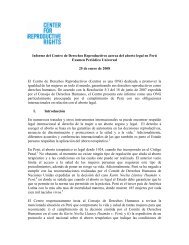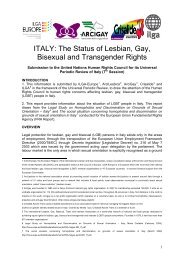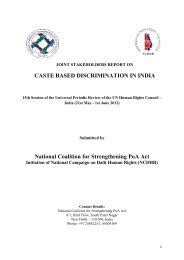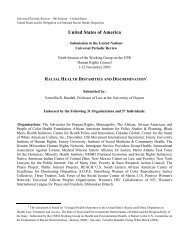Prison Needle Exchange: Lessons from a Comprehensive Review ...
Prison Needle Exchange: Lessons from a Comprehensive Review ...
Prison Needle Exchange: Lessons from a Comprehensive Review ...
You also want an ePaper? Increase the reach of your titles
YUMPU automatically turns print PDFs into web optimized ePapers that Google loves.
sophically supportive of the use of substitution treatment. In Canada and internationally, such<br />
physicians may not be present in all prisons.<br />
Similarly, prisoners may continue to inject illicit drugs, including drugs other than heroin,<br />
even during MMT treatment. This reality has been recognized by the Spanish government<br />
and is cited as one of the reasons for allowing prisoners on methadone programs to also<br />
access needle exchange. 282 Ongoing injection of heroin might occur where prisoners do not<br />
receive a methadone dose sufficient to address withdrawal symptoms, or where prisoners<br />
inject narcotics to self-treat pain associated with chronic illness.<br />
Finally, methadone is only a useful treatment for opiate dependency. It is not a harmreduction<br />
option for those who inject non-opiates such as cocaine. Therefore, MMT does not<br />
address the unsafe injecting practices of these drug users.<br />
To summarize, while MMT is an essential element of a harm-reduction strategy, alone or<br />
even in combination with bleach distribution, it is not a sufficient response to the risk of disease<br />
transmission via injection drug use in prisons. Furthermore, for reasons similar to those<br />
set out in the preceding section on the inadequacy of bleach, the implementation of needle<br />
exchange programs in prisons has achieved other important benefits in the areas of prisoner<br />
health and staff safety that cannot be replicated by MMT alone or in combination with bleach.<br />
Opinions of prison staff<br />
Part of the reluctance of Canadian federal and provincial/territorial governments to introduce<br />
needle exchange programs is attributable to the real and expected objections of staff. In 1999<br />
the Union of Solicitor General Employees, representing correction-<br />
al officers, opposed needle exchange programs in federal institutions.<br />
283 However, the evidence regarding the attitudes of individual<br />
prison staff with respect to needle exchange programs is inconclusive.<br />
For example, when researchers <strong>from</strong> the Expert Committee on<br />
AIDS and <strong>Prison</strong>s surveyed CSC staff attitudes toward HIV prevention<br />
initiatives, 15% of correctional officers and 31% of healthcare<br />
staff were in favour of making syringe exchange programs<br />
available to prisoners. 284 The survey was conducted 10 years ago.<br />
Since that time there has been new evidence of significant increases<br />
in HIV and HCV infection rates among prisoners, of the successful and safe implementation<br />
of prison needle exchange programs in other jurisdictions, of the implementation and<br />
subsequent expansion of MMT in federal prisons, and of updated HIV/AIDS education programs.<br />
Attitudes and opinions can change. This change can result <strong>from</strong> knowledge and information<br />
gained through first-hand or through workplace education programs. Therefore, it is<br />
reasonable to expect that the number of staff supporting the implementation of needle<br />
exchange programs would be higher today.<br />
Canadian elected and prison officials should be aware of the evidence of staff attitudes in<br />
other jurisdictions. A recent review of studies of needle exchange programs in Switzerland,<br />
Germany, and Spain found that staff were generally supportive of the programs, although<br />
survey response rates varied. 285 And as noted in this report, particularly in relation to the situation<br />
in Germany and Moldova, staff attitudes have changed as staff have learned first-hand<br />
about the needle exchange programs and the harm-reduction ethos, and as they have participated<br />
in the implementation and review of needle exchange programs.<br />
It is important to highlight that Canadian jurisdictions have safely and successfully introduced<br />
harm-reduction measures such as condoms and bleach in prisons in recent years<br />
despite the initially controversial nature of such measures. The implementation of these programs<br />
has demonstrated that despite initial concerns in some quarters, harm-reduction mea-<br />
A recent review of studies of<br />
needle exchange programs in<br />
Switzerland, Germany, and<br />
Spain found that staff were<br />
generally supportive of the<br />
programs.<br />
<strong>Needle</strong> <strong>Exchange</strong> Programs Should Be Implemented in <strong>Prison</strong>s in Canada 63



